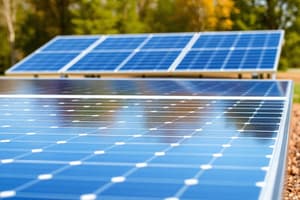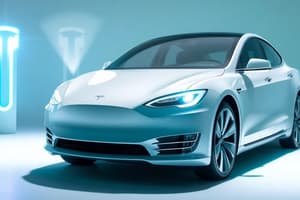Podcast
Questions and Answers
What condition is necessary for the equilibrium adoption of clean technology?
What condition is necessary for the equilibrium adoption of clean technology?
- The subsidy must be equal to the profit from dirty production.
- The profit from clean technology must exceed the profit from dirty production.
- Clean technology must be regulated to equalize production levels.
- The difference between clean and dirty production must equal cost. (correct)
When only subsidies for clean technology are applied, what is the outcome regarding carbon emissions from dirty firms?
When only subsidies for clean technology are applied, what is the outcome regarding carbon emissions from dirty firms?
- Carbon emissions are reduced to optimal levels immediately.
- Carbon emissions from dirty firms are effectively eliminated.
- There is no change in carbon emissions from dirty firms. (correct)
- Subsidies lead to zero emissions from all firms.
What is the relationship between the efficient level of clean technology and the subsidy provided?
What is the relationship between the efficient level of clean technology and the subsidy provided?
- The subsidy is always greater than the profit margin of dirty firms.
- The subsidy must equal the market price of clean energy.
- The subsidy has no correlation with the efficiency of clean technology.
- The subsidy equals a factor of dirty production metrics. (correct)
Why is subsidizing clean technology without regulating existing dirty production considered a second-best policy solution?
Why is subsidizing clean technology without regulating existing dirty production considered a second-best policy solution?
What was indicated about the future discussions regarding optimal clean technology policy?
What was indicated about the future discussions regarding optimal clean technology policy?
What is the key characteristic of a dirty firm's production in relation to externalities?
What is the key characteristic of a dirty firm's production in relation to externalities?
How does an externality tax impact the profit maximization condition of a dirty firm?
How does an externality tax impact the profit maximization condition of a dirty firm?
Which factor was most critical for the growth of solar energy from 2010 to 2020?
Which factor was most critical for the growth of solar energy from 2010 to 2020?
What is the effect of adopting clean technology on the externality produced by a firm?
What is the effect of adopting clean technology on the externality produced by a firm?
What determines the optimal clean energy policy in terms of firm behavior?
What determines the optimal clean energy policy in terms of firm behavior?
What role does a subsidy for clean firms play in the market equilibrium?
What role does a subsidy for clean firms play in the market equilibrium?
What is the relationship between the externality tax and the input choice for a dirty firm?
What is the relationship between the externality tax and the input choice for a dirty firm?
In the context of environmental externalities, what does the term 'displaced emissions' refer to?
In the context of environmental externalities, what does the term 'displaced emissions' refer to?
What condition must firms satisfy to be indifferent between adopting clean or remaining dirty technology?
What condition must firms satisfy to be indifferent between adopting clean or remaining dirty technology?
Which of the following best describes the profit function for a clean firm?
Which of the following best describes the profit function for a clean firm?
What does the optimal tax τ equal according to the first-best level of kd?
What does the optimal tax τ equal according to the first-best level of kd?
In the profit equation for a dirty firm, which term represents the cost of production?
In the profit equation for a dirty firm, which term represents the cost of production?
What is the relationship between q (the fraction of clean firms) and welfare W in the equation provided?
What is the relationship between q (the fraction of clean firms) and welfare W in the equation provided?
What does maximizing W with respect to q yield in terms of clean technology assessment?
What does maximizing W with respect to q yield in terms of clean technology assessment?
Which of the following is NOT a component of the clean firm's profit equation?
Which of the following is NOT a component of the clean firm's profit equation?
How does the adoption cost C affect the clean firm's decision-making?
How does the adoption cost C affect the clean firm's decision-making?
Flashcards
Clean Technology Subsidy
Clean Technology Subsidy
A subsidy given to promote the adoption of clean technology. This can be done even without regulating dirty production.
Equilibrium Adoption Condition
Equilibrium Adoption Condition
The condition where clean technology is adopted efficiently, often without government subsidies. It's when πc∗(0) − πd∗(τ) − C = 0
Optimal Clean Energy Policy
Optimal Clean Energy Policy
The best policy for motivating the transition to clean energy technologies.
Clean Technology Mandate
Clean Technology Mandate
Signup and view all the flashcards
Subsidy and Externalities
Subsidy and Externalities
Signup and view all the flashcards
Solar energy and externalities
Solar energy and externalities
Signup and view all the flashcards
Regional variation in emission displacement (solar)
Regional variation in emission displacement (solar)
Signup and view all the flashcards
Germany's solar displacement
Germany's solar displacement
Signup and view all the flashcards
Clean technology
Clean technology
Signup and view all the flashcards
Dirty technology
Dirty technology
Signup and view all the flashcards
Externality (in context of technology)
Externality (in context of technology)
Signup and view all the flashcards
Tax on externalities
Tax on externalities
Signup and view all the flashcards
Dirty firm's equilibrium profits
Dirty firm's equilibrium profits
Signup and view all the flashcards
Clean firm's equilibrium profits
Clean firm's equilibrium profits
Signup and view all the flashcards
Clean technology adoption
Clean technology adoption
Signup and view all the flashcards
Efficient clean technology adoption
Efficient clean technology adoption
Signup and view all the flashcards
First-best level of dirty technology (kdFB)
First-best level of dirty technology (kdFB)
Signup and view all the flashcards
First-best tax (τ)
First-best tax (τ)
Signup and view all the flashcards
First-best level of Clean technology (qFB)
First-best level of Clean technology (qFB)
Signup and view all the flashcards
Social welfare (W)
Social welfare (W)
Signup and view all the flashcards
Study Notes
Renewable Energy
- Lecture on renewable energy, Economics 134 L16, at UCLA on December 4, 2023.
- Course evaluation is needed, encourage students to log into MyUCLA.
- Extended office hours are available Wednesday from 5:00 pm to 7:30 pm.
- Final exam schedule is Sunday, December 8, 3:00 pm to 6:00 pm
- Exam locations and assignment groups are by last name: A-G: Perloff 1102; H-P: Dodd 121; Q-Z: Haines 220.
Clean Technology
- Important innovations include renewable energy and electric vehicles.
- Renewable energy is discussed today and electric vehicles in the next lecture (L18).
Two Externalities
- Two main reasons for renewable energy subsidies:
- Negative externalities from fossil fuel production (air pollution, climate change).
- Positive externalities in innovation.
Solar Energy
- Analysis of solar energy trend from 2005-2020. Increase installations, government support and cost declines are seen.
- Government support, cost reductions and environmental externalities were prominent areas for the 2010-2020 decade of solar. Optimal energy policy and making a transition to cleaner technology were other significant focuses during the period.
- Stylized facts from 2005-2020 include a significant increase in solar energy installation, a substantial increase in government support, and tremendous cost declines.
- Details on the rise of solar energy capacity and cumulative installations in different nations from 1996-2020 were presented.
- Share of electricity production from solar in various countries from 1996-2021. Significant growth seen by many countries during the period.
Renewable Energy Incentives in the U.S.
- Two major sources in the U.S. for renewable energy incentives:
- State mandates (especially "renewable portfolio standards"). 29 states implemented these mandates. These were passed in 2005
- Federal subsidies: Primarily focuses on investments and production tax credits. Over 51billioninsupportfrom2005−2015wasprovided.SignificantadditionalsupportisanticipatedundertheInflationReductionActof2022,estimatedat51 billion in support from 2005-2015 was provided. Significant additional support is anticipated under the Inflation Reduction Act of 2022, estimated at 51billioninsupportfrom2005−2015wasprovided.SignificantadditionalsupportisanticipatedundertheInflationReductionActof2022,estimatedat320 billion over 2022-2030.
California's Renewable Portfolio Standard
- Details on California's projections for the renewable portfolio standard, especially for the solar and all renewables.
- Projections were provided for 2020-2045. Projections for the generation share percentages were projected up to 2045.
Federal Subsidies
- Various sources of federal subsidies over the timeframe 2005-2015.
Cost Declines
- Detailed information about solar panel price indexes excluding subsidies, in addition to worldwide cumulative capacities, from 1983-2015.
- Price per watt of solar photovoltaics (PV) modules (logarithmic axis), in 2019 US$. Important data on these costs are shown over time, correlating with cumulative installations.
- A consistent trend of decreasing cost per megawatt-hour of electricity from various energy sources such as solar PV, offshore wind, onshore wind, nuclear, and coal from 2010 to 2019 along with the cumulative installed capacity were presented.
Discussion
- Correlation does not equal causation. Important to consider confounding variables when analyzing cost declines in renewable energy. The past may not accurately predict the future.
- Economies of scale vs. learning-by-doing may be important factors in shaping the cost decline pattern.
Externalities (Environmental Externalities)
- Renewable energy does not generate carbon emissions, but the effects of policies may change aggregate energy demand.
- Regional variations in displaced emissions in the U.S.
Detour: Germany
- Germany's solar power generation from 1997-2021 with a focus on significant increase in adoption over the period.
- Germany's natural gas consumption from 1997 to 2020.
- Germany's nuclear power generation from 1996-2021 including a sharp decrease in nuclear generation after 2010.
Optimal Clean Energy Policy
- Analysis of optimal clean energy policies focusing on the transition to clean technology, and clean vs. dirty firms (production, cost and profits).
- Optimal tax and subsidies relating to clean energy.
Next Time
- Review of the lecture analysis of clean energy policy.
- Electric vehicles will be the focus of the next lecture.
Studying That Suits You
Use AI to generate personalized quizzes and flashcards to suit your learning preferences.




